Don’t smother your tree trunk. Let it flare!
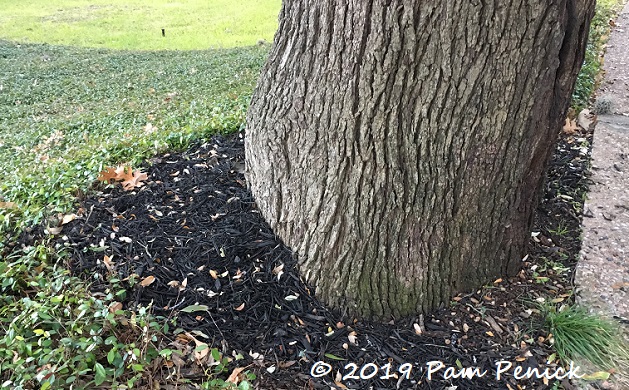
How many times have you seen a tree trunk that looks like this? It looks nice and neat, right? The trunk is tidily surrounded by mulch that’s layered right up against the bark. Maybe under that mulch there’s also a layer of soil added when sod was laid or other plants were planted around the tree.
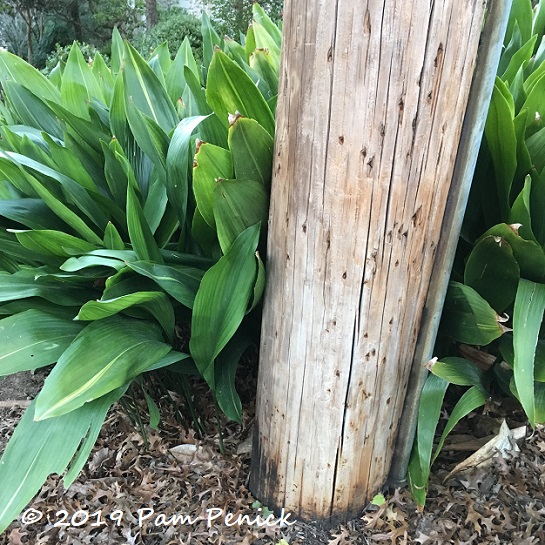
It bears a striking resemblance to a telephone pole, a straight post rising from the soil.
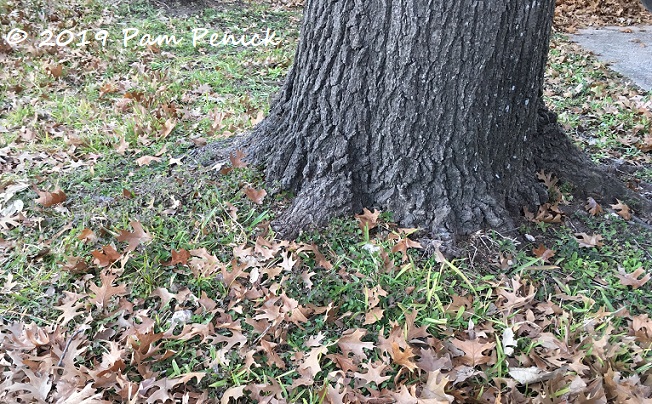
Unfortunately, that’s not what a healthy tree trunk looks like. A healthy mature tree has a visible skirt of roots called the root flare, like the tree pictured above. (Not all trees flare so obviously, but most do.)
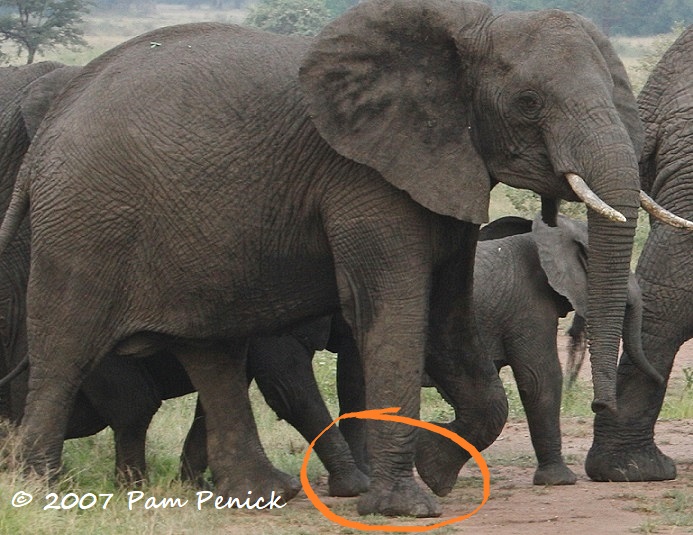
The trunk should resemble an elephant’s foot, not a telephone pole.
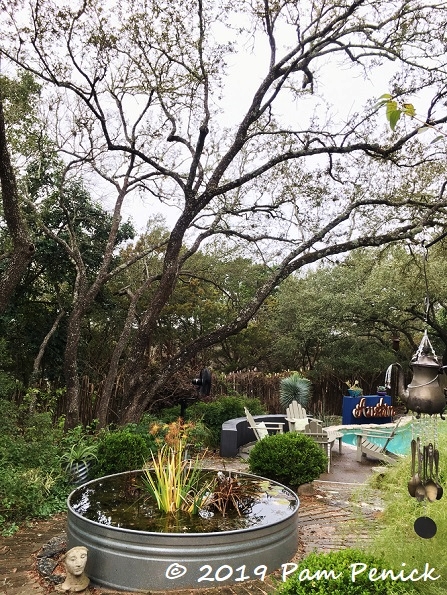
Yesterday I shared pictures of two mature live oaks in my garden that were dying, which we had to remove, losing shade, beauty, and, yes, money I’d rather have spent on other things.
Why were they dying?
The trees were suffocating. Their trunks looked more like telephone poles than elephants’ feet, and I hadn’t noticed. But it was worse than just mulch piled up on the root flare. After all, I knew better than to do that, and I’d worked hard to make a healthy garden without harming the trees over the past decade. No, this problem was deeper than could be seen.
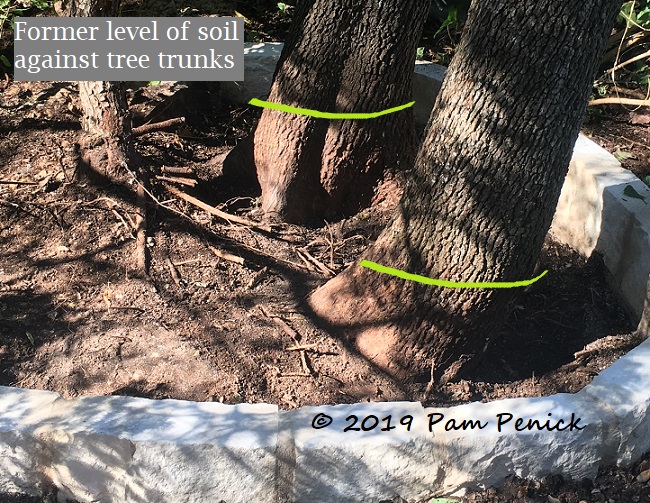
Our arborist suspected that the trees were not getting enough oxygen through their shallow surface roots, and he advised excavating the soil around the trunks to see what was going on. What we discovered shocked me. The tree trunks were buried nearly a foot deep in soil — soil that I suspect was brought in to level the sloping back yard, perhaps 15 years ago when the pool was installed. They were also being choked by long-buried landscape fabric that had been laid atop their root zone.
The trees soldiered on for more than a decade (that’s how long we’ve been here), even as they struggled to breathe under all that soil. Desperate for air, the trees were forming a dense mass of girdling roots around their trunks. As I gardened around them, I didn’t know what was happening. Not until it was too late.
Making a tree well
Anxiously, I had the other trees in that part of the yard excavated too. Again, we found 8 to 12 inches of soil layered on top of their root flares (see photo above) but no evidence of girdling roots or rot. These trees could be saved, our arborist advised, by removing the excess soil to expose the flare and constructing a tree well to hold back surrounding soil, preventing it from settling back over the roots. (Several roots of an adjacent evergreen sumac were severed during the excavation. I dearly hope it will survive too.)
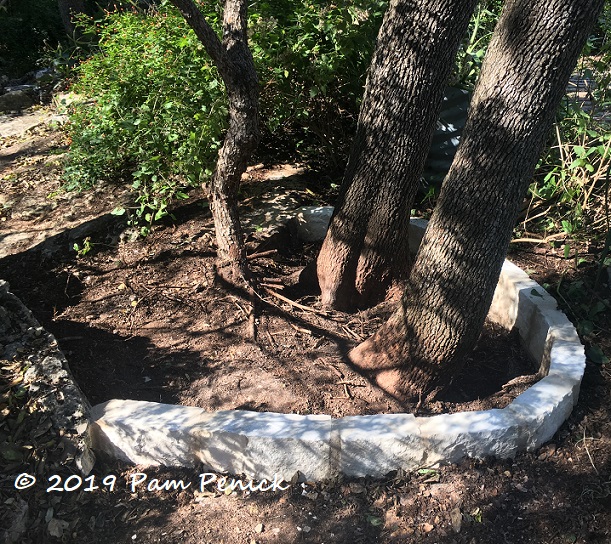
A tree well is a protected space around the base of a tree. Ideally it should be generously proportioned, especially for mature trees. But our arborist says even a modest diameter around a tree’s root flare improves air flow. I had a landscaper mortar a half-circle of stacked limestone blocks around the trunks to keep soil on the higher side from washing into the well. I’ll spread a thin layer of coarse wood mulch or gravel in the well to keep it from turning into a mud pit when it rains, with the mulch pulled away from the trunks. No volcano mulching, for sure!
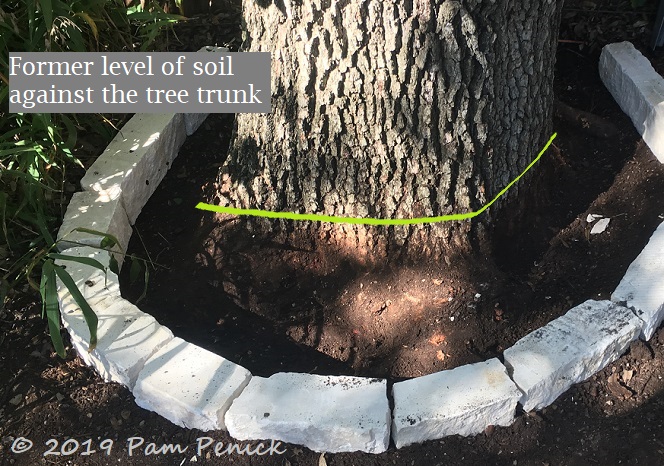
I’m slowing excavating other trees that look more like telephone poles than elephants’ feet. Only in that one area does it appear that soil was added to level the yard, burying several trees in the process. But even so, my arborist has pointed out other trees that I believed had sufficient flare, and advised excavating them some more. The tree pictured above had about 6 inches of soil and compacted mulch over its root flare.
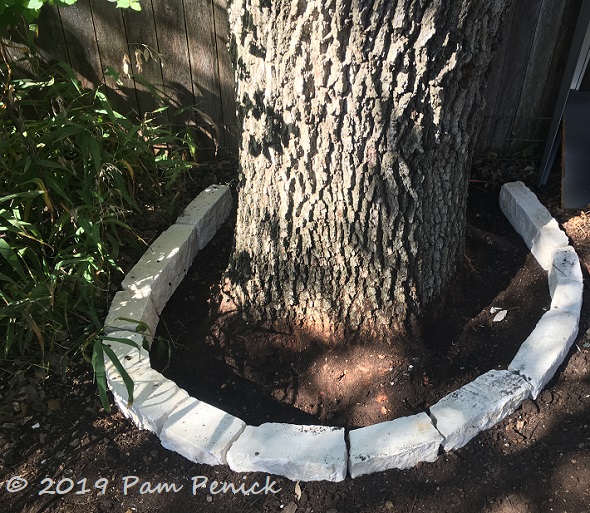
Because this tree is next to a pathway, the protective tree well is smaller than I’d prefer. But it’s better than it was.
Keep it simple, keep it low
Not every tree requires a stone edge to protect the tree well. Most of mine just need a couple of inches of soil and built-up mulch scraped away from the base of the trunk. Maintenance involves not spreading mulch up against the trunks in the future and making sure landscaping crews know not to do that too.
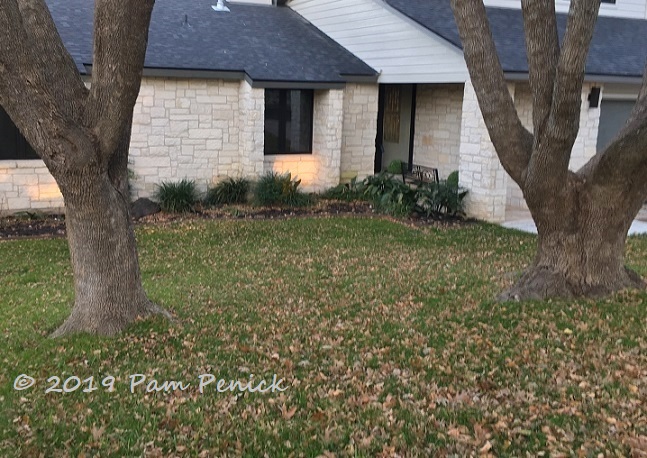
Here’s a pair of healthy root flares I spotted on a stroll around the block. Nothing fancy here. Just a natural flare, with no excavation or stonework required. My arborist prefers thirsty turf grass be removed from the base of a tree, replaced by a thin, coarse layer of mulch spread under the dripline of the tree’s canopy. But the key is making sure that flare is getting air!
By the way, I highly recommend my arborist, Vincent Debrock of Heritage Tree Care. His company takes care of trees on the Hike-and-Bike Trail and at the Texas Capitol, and he gives time and thoughtful consideration to much smaller projects like mine as well. I’m getting no discount for my recommendation, by the way. I just think Vincent knows and cares about trees.
Now, check on your tree flares this spring. Make sure they’re not suffocating from any gardening you’ve done or previous owners may have done. The damage going on below-ground can take decades to show above-ground.
__________________________
Digging Deeper
Come learn about gardening and design at Garden Spark! I organize in-person talks by inspiring designers, landscape architects, authors, and gardeners a few times a year in Austin. These are limited-attendance events that sell out quickly, so join the Garden Spark email list to be notified in advance; simply click this link and ask to be added. Season 8 kicks off in fall 2024. Stay tuned for more info!
All material © 2025 by Pam Penick for Digging. Unauthorized reproduction prohibited.


For goodness sakes. What a thing to do to trees. I hope all your trees respond to the good care you are giving them. Lucky that you have an arborist that knows his trees so well. I will be looking at my trees this afternoon.
Good for you, Lisa. I take it that means you’re not buried under snow like so much of the country. 🙂
Amen for this great post! Sharing : )
Thanks for sharing it, Laurin. I hope it will save some trees.
This is a great public service announcement, Pam, and I love the telephone pole vs. elephant foot comparison.
I recently angered a neighbor by saying, “You probably already know this, but your landscaper has piled mulch up around the base of your trees. It can cause them to die.” He replied he’d been doing it for 5 years so it didn’t seem to be a problem. He added “Missy” to the end of his response, which indicated how well the info was received. Maybe he’ll still be there and have a lightbulb moment when the tree removal or roof repair hits his wallet.
The damage is clearly not obvious until it’s too late.
Very true. Tree care, as our arborist pointed out, gives gardeners an entirely different experience of time. Things you do or don’t do today can have an impact 10 or 20 years down the road. It’s like raising a child in that regard.
I have a neighbor like that as well. I’ve stopped giving suggestions.
Of course I ran out to look at my trees as soon as I read this post. I think they are okay, but I remember reading once that with very old homes with older trees sometimes years of accumulated leaves can make the level of the soil go up and my guess is this could eventually be a problem. I sent a link to this post to my daughter who will soon be planting new trees. Thanks, Pam!
You’re welcome, Laura!
This is very good to know & easy to remember with your examples of the telephone pole and the elephant foot. Thanks, Pam!
Sometimes a picture is worth a thousand words. 🙂
We had some trees that were like that too. Our house is built on a slope. It was not a new house when we bought it so I just assumed whatever was going to happen had already happened. But we have lost a few trees, and we may lose a few more.
I’m sorry, Bill. It really can take quite a few years for problems to show up.
Thanks for sharing your story, Pam. The lesson is helpful. I’m just sorry that your garden was negatively impacted.
Thanks, Kris.
So, at a native plant symposium today one of the speakers was from the National Forest Service talking about restoring the forests in north Georgia. Burning is one of the methods they use to remove the duff layer and expose the trees’ flare. Essentially it is what you discuss in this post but on a much larger scale. I thought it was pretty interesting. He showed photos with trees as poles and then with the exposed flare just like you explained. I knew it already because I read your post!
Burning — interesting! (Don’t try this at home, kids.) Thanks for sharing about the symposium, Karin.
Yes, I should have put in a disclaimer Pam- controlled burning by professionally trained people. Definitely not something that you should do in a home garden. 🙂
What a great post! Thanks for sharing what most of know already, but in a form that we can also be aware retro-actively. Who would have know that so much mulch had built up prior to when you bought the house, after all?
Thanks, Lisa. To clarify, it wasn’t mulch over the trees’ roots that were dying. It was soil, a good 12 inches of it. But too much mulch can be bad too.
This is such a great post, Pam! I’m all about the elimination of mulch volcanoes (they get me so worked up, especially when professionals or municipalities do this), but the issue of covering up the root flare never occurred to me. In fact, I had never even heard that term before. I’ll definitely be taking a good long look at the trees on our property this spring. Thanks for the heads up!
You’re welcome, Margaret!
I have three big cedars (two incense and one deodar), and they have elephant’s feet. Fortunately, they grew big enough, and were strong enough to break through the black plastic that was laid down everywhere (literally) in every bed, right up to their trunks! I spend months when I first moved in pulling up plastic. I still find more. It’s true, I have a lot more weeds, but how they ever got any water I don’t know.
Gah, what a mess and lot of work that must have been, Lisa. As for the weeds, they always find a way. 😉
Thanks for sharing your experience Pam. What about surface roots? I’m curious about the effect added soil or cement patios or asphalt parking lots have on the surface roots that extend out to the drip line (and beyond). I frequently see the new construction of parking lots with tree “islands” throughout. That is- the area is paved to within a few feet of the tree trunk. Is this just as harmful as burying the flare? Will these trees eventually decline and die? Thanks for your thoughts.
Putting soil, asphalt, even paving stones atop surface roots is not good for the tree, Kimberly. Not being an arborist, I don’t know how much of that kind of stress they can take and still survive. It probably depends on the type of tree and other conditions. Their roots need to breathe and get water.
Of course gardens are for people too, and sometimes you’ve got to have a path or patio. Avoid paving or adding soil under the canopy. Instead make permeable patios of loose gravel or spaced-out flagstones so air and water can get through to the roots.
Pam, you probably will save a lot of trees with this blog post! So many people don’t realize the damage done to trees because the flares are covered with soil or mulch. A professional arborist with an air spade will work wonders if the tree needs a heavy duty rescue. Also, advise people when planting new trees to NOT plant too deeply but keep the tree a few inches above the hole since it will sink a little with time. Sorry about loosing your trees but thanks for spreading the lesson on root flares!
Excellent advice, Melody! I was just reading that planting too deeply in the first place often leads to tree death years later. Trees may even come from the nursery planted too deeply in their nursery pots! It pays to scrape away the soil around the trunk enough to see what’s going on before planting, and adjust the depth of your planting hole accordingly.
Great Post! very much appreciated.
I’m glad you found it helpful, Doris.